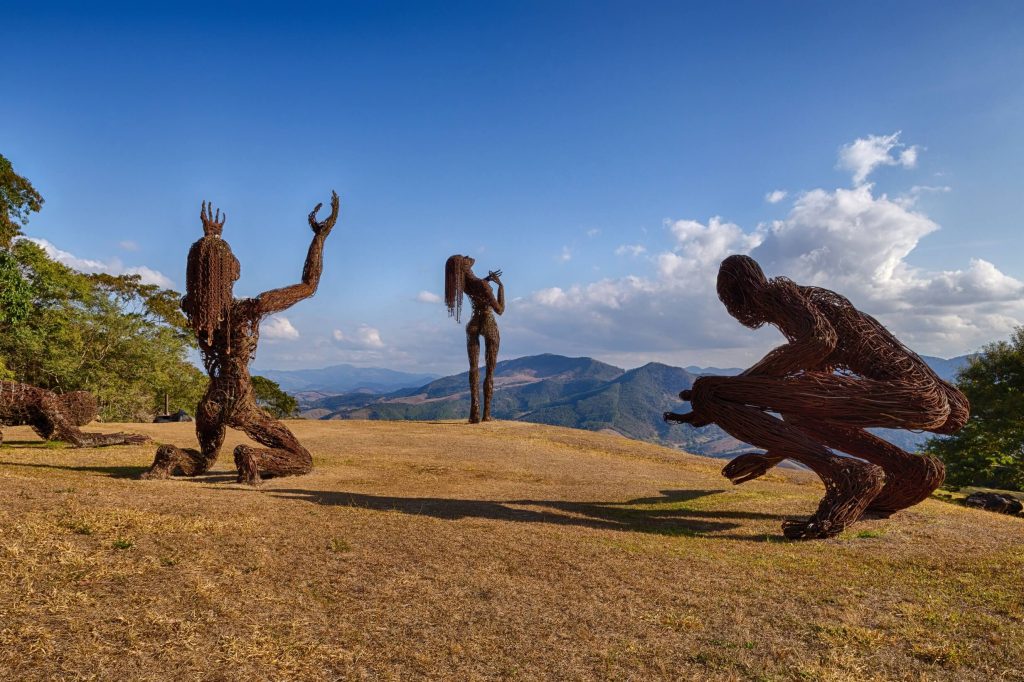How the Statues got to Ibiti

"I never imagined, not even in my wildest dreams, that they would come to a place like this. I'm very happy to be here with them," says artist Karen Cusolito on her most recent visit to her work, in 2022, at Pedra do Tatu, where her Big Family, known simply as the Statues, "live". This record can be seen in "My Big Family - Revisited", an 18-minute mini doc available on Ibiti Projeto's YouTube channel. Crossing oceans In between Karen's speeches, the film, directed by Mauro Pianta, also shows how the Statues made their way from California (USA) to Ibitipoca (MG) in 2014. The images were taken by Felipe Scaldini, director of another film, "Migration", which documents this journey in detail, also available on the Ibiti Projeto YouTube channel. Transportation from the Pacific to the Atlantic was no easy task, as Renato Machado recalls. Founder of Ibiti, he found out about the work when he was passing a shed: "I had suggested cutting the sculptures and then casting them here, with a specialized and reliable team. But then Karen said to me: 'Renato, you're not going to cut up my children, are you?' And she herself helped to make some 'beds' to lay the statues on, which came on the ship in one piece. To get them up to the top of the mountain, we had to open a road for the tractor to pull up with the crane, and then we closed it and planted them on top." A destination Karen made a point of getting to know the place where the Big Family would be moving. "I wanted it to be a destination, not an obvious place like next to the Pousada do Engenho. So I suggested three places, hoping for this one, which she also liked. Then she did three layouts and asked me to choose one, and again we agreed," says Renato. For him, the work took on a new meaning when it came to Minas. "It's an artwork very much in line with our project, because it's recycling, it's garbage that has been transformed into something better, a 'regeneration'. And it's certainly art made with steel that left Minas Gerais, had its use on the planet and came back here, because our state is a major supplier of ore to the world." Feeling translated Karen Cusolito took around three years to complete the work and presented it in 2007 at the Burning Man Festival in the United States. At its center was an oil derrick, representing the god of today. "The intention was to show our ambition for oil and how it impacts on the economy and environment of almost every culture around the world." Karen made art installations in Boston until she moved to San Francisco in 1996. There, she runs American Steel Studios, a huge warehouse in the suburb of Oakland, where more than 200 artists and creative entrepreneurs work. It was there that, over the course of a few years, she created the set of sculptures. About the strong presence of the human body in her sculptures, the artist comments: "The human form is a rich arena for exploring and expressing emotion, intention and challenge". Most of her work focuses on humanity and the environment and "the delicate balance between the two". Get to know the meaning of each sculpture ACHMED Represents the Muslim part of the world. It connects to the Earth with humility and devotion MUMBATU Slender and strong, it refers to African traditions. By sowing, it suggests the partnership between human beings and nature ECSTASY It seems to be in movement and, according to Karen, is "something of a hippie, sun worshipper, in joy with nature" EPIPHANY In a moment of enlightenment, it represents clarity, joy, the appreciation of life PASSAGE It shows creativity and tradition being passed down from one generation to the next: mother and child walk together HUMBLE GEORGE The knight, in a posture of acceptance, reflects calm, the Christian faith



